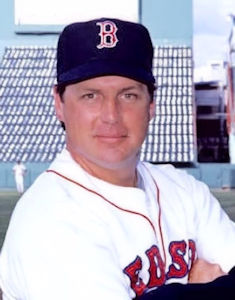 |
Tom Seaver was one of baseballís greatest right-handed power pitchers, a Hall of Famer who won 311 games, most notably for the New York Mets, whom he led from last place to a surprise world championship in his first three seasons. Until his arrival, no Mets pitcher had ever won more than 13 games in a season. Seaver won 16 in his first year and 16 more the next. From 1969 on, Seaver was a celebrity. He was part of a new generation of sports heroes in New York along with Joe Namath and Walt Frazier. Seaver at work was a picture of kinetic grace. He had a smooth windup, a leg kick with his left knee raised high, and a stride so long after pushing off the mound that his right knee often grazed the dirt. With precise control, he had swing-and-miss stuff. Seaver struck out more than 200 batters in 10 different seasons, a National League record. In 1970, facing the San Diego Padres, he struck out a record 10 batters in a row to end the game. He was having a good season in 1977 when he was traded to the Cincinnati Reds for four players of far lesser stature. After five and a half seasons in Cincinnati, the Mets brought him back in another trade. But in 1984, baseball held a free agent compensation draft, and believing that no other team would want an aging pitcher with a big salary, the Mets left Seaver unprotected and the White Sox grabbed him. Two years later, in 1986 the Red Sox were on the road to the American League pennant. Bruce Hurst struck out 11 batters on April 12th but lost a five-hitter to Seaver. Then, a week later, Hurst out-dueled Seaver in a 2-1 Red Sox victory. After Seaver's mother passed away that year, he wanted to play closer to his home in Connecticut to spend more time with his family. So Sox GM, Lou Gorman solidified the Red Sox pitching staff, by trading Steve Lyons to the White Sox to get him. Seaver got his Red Sox career off to a good start by being on the winning side of a 9-7 win over the Blue Jays on July 1st. But Seaver's Red Sox career was the epitome of bad luck for him. He got very little run support in the games he pitched. When he lost to the Angels on July 27th, he had allowed just three runs in his last four starts and had lost three of them, being shut out twice. He was 2-4 with the Red Sox and had done the job they wanted him to do. His ERA was 3.57 and he had pitched at least six innings in each of his seven starts. His bad luck continued on August 2nd, when he walked off the mound with a 2-1 lead in the seventh inning, only to see the bullpen turn it into a 13-2 loss. Seaver had probably his best game in a Red Sox uniform, a week later, on August 8th, winning 6 to 1. He retired 11 straight from the third inning through the seventh and 17 of 18 from the first through the seventh. He took a one-hitter into the seventh and had at least one strikeout in every inning after the first. Then on September 19th in Toronto, he felt something pop in his left knee. He didn't know it at the time, but he had torn the ligament. He never threw another major league pitch, retiring when the season ended. The Sox won the American League pennant and went on to meet the New York Mets in the World Series. It was pure irony that Seaver was now on the other team and on the Red Sox dugout steps to witness the Mets' miracle win from the other side of the diamond. |
|||||
